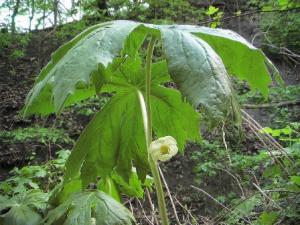Mayapple

Podophyllum peltatum, commonly called May apple, is a herbaceous perennial plant in the family Berberidaceae, native to eastern North America extending westward to Minnesota and Texas. A spring ephemerals, the plant emerges in the spring and slowly begins to die off during mid to late summer. The plant grows 1.5 to 2 feet tall, with 2, occasionally 3 palmately lobed leaves 8-11 inches in diameter. The plant also produces a single white flower, with six (rarely up to nine) petals from each erect stem at the axil of the two leaves. The flowers mature into a greenish-yellow fruit 1 to 2 inches long. May apple prefers moist, fertile soils such as those of woodlands and pastures and appears in clonal colonies. Individual shoots are often connected by systems of thick rhizomes.
This plant should be considered toxic for pets as all parts of the plant contain podophyllin, a bitter, cytostatic resinous compound. Podophyllin has a number of effect on the body. It is both a potent irritant of living tissue and a strong laxative. It also interferes with normal cell division inhibiting cell growth and multiplication. The most common symptoms of ingestion are colic and diarrhea. More often than not, there will also be indications of the toxins irritant properties such as excessive salivation, swelling/blistering of the muzzle, and swelling of the mouth and throat. Additionally the eyes and eyelids may become irritated and swell shut as the resinous toxin is transferred from the mouth to the face; such as would be the case when an animal paws at the mouth and face in response to the plants irritant properties.
Serious or potentially life threatening intoxication as a result of may apple ingestion is rare. The plant is bitter in taste and acts as an immediate irritant when it comes in contact with skin; both of which tend to dissuade overconsumption. As a result livestock will typically avoid ingestion the plant unless deprived of their normal forages, thus forcing them to eat it. In most cases the symptoms will be limited to dermatological issues and gastrointestinal upset. In the vast majority of cases pets and livestock will make a full recovery once they are prevented from eating the plant.
Avoid further ingestion of the plant and consult a veterinarian. Outside of an allergic reaction, there is probably little chance that a dog or cat would suffer potentially serious consequences from a onetime ingestion of a moderate amount of the plant. Additionally the irritant properties of the the plant make it very unlikely that a dog or cat would ingest enough of the plant or on a consistent enough basis to suffer serious consequences. As a result the extent of symptoms for a dog or cat would likely be limited oral irritation/ inflammation and/or gastrointestinal upset (mild vomiting, diarrhea) from eating or attempting to eat the plant. In regards to a specific treatment regimen, common sense symptomatic care will probably be all that is required. If the ingestion was recent remove any existing plant matter from the mouth and flush thoroughly with water. If vomiting does not occur it may be induced by giving and emetic such as 3% hydrogen peroxide orally at a dose rate of 1 teaspoon per 10 lbs of body weight. The pet will more than likely start vomiting spontaneously without the help of an emetic, as their body tries to expel this non digestible material. The universal antidote, activated medical charcoal may also prove to be of some use in absorbing the toxins.
In the event that a dog or cat is suffering gastrointestinal upset as a result of ingesting this plant, ensure the pet gets plenty of fluids to avoid possible dehydration caused by diarrhea. To alleviate the gastrointestinal upset and diarrhea; Kapectolin may be given at a dose rate of 1 to 2 ml/kg four times a day. Kapectolin provides a coating action that protects the stomach lining. Sucralfate may also be used as for gastrointestinal irritation as it reacts with the acids in the stomach to form a paste-like material capable of acting as a barrier between the stomach and its contents. Sucralfate is typically given to dogs weighing more the 60lbs: 1g every 6 to 8 hours; for dogs under 60 lbs: 0.5g every 6 to 8 hours; Cats: 0.25g every 8 to 12 hours to reduce irritation of the stomach and intestines. The prognosis is good and the pet should make a full recovery within a 1 to 24 hours.
For grazing animals ensure that they are provided with adequate sources of food as most will only eat this plant as a last resort. In the event that the plant is ingested, common sense symptomatic care will probably be all that is needed. Prevent further ingestion of the plant, flush mouth with water, consult a veterinarian.




